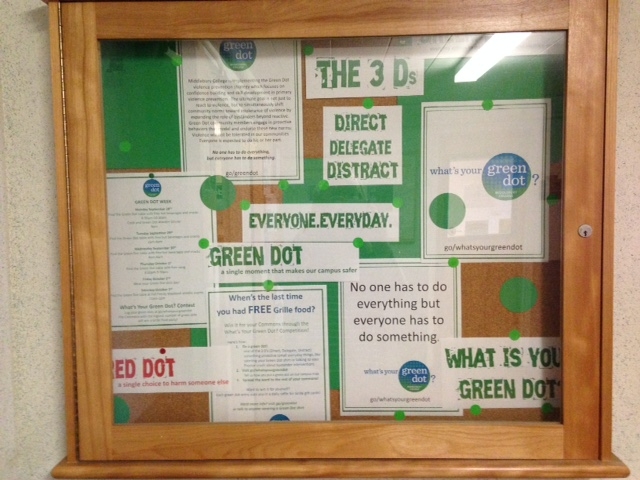Green Dot Overview

How Green Dot Works
Green Dot is based on of the idea that collectively, small actions have large impacts. These smalls steps very quickly become a movement, and this movement creates a culture shift. This culture shifts creates a community that says violence will not be tolerated, and we will all do our part to create a safer community.
Thousands of people are victims of sexual assault, partner violence, and stalking every year. We define these acts of violence as red dots. Red Dots are:
A moment in time where someone’s words, choices, or actions contribute to Power-Based Personal Violence in some way. Red dots are the moments it takes to raise a hand against a partner, to continue to text, call, and message someone after they have been asked to stop, or to force someone into a sexual situation without consent.
With enough Green Dots, we can outnumber the red dots and reduce the rates of violence. Green Dots are:
A moment in time where someone’s words, choices, or actions reduce the likelihood that someone will be harmed by violence or proactively communicate an intolerance for violence. Green dots are the moments it takes to ask if someone is okay, to get help in a potential red dot situation from a friend, roommate, or dean, or to create a distraction by telling an unrelated story to diffuse the situation.
You don’t have to be a superhero to put a green dot on our campus map. In fact, green dots can be simple and small. What’s important is that everyone in our community chooses to do something about violence on our campus. No one has to do everything, but everyone has to do something.
Though there may be barriers when making the choice to step in, you have options. The 3Ds are the toolbox of the Green Dot program that demonstrate the variety of strategies you can use when making the choice to intervene. Saying no to violence is always the right decision and the 3Ds help you say no in a way that works best for you. The 3Ds are: Direct, Delegate, and Distract.

Direct - Directly inserting yourself into a potential red dot situation and stopping it by addressing those who are involved.
Asking someone who seems uncomfortable or unsure if they are ok.
Pulling your friend away from someone who keeps pushing drinks on them.
Telling your buddies that you think their joke about sexual assault is offensive.
Delegate - If you feel unsafe or uncomfortable stepping in yourself, getting someone to intervene for you who might be more equipped or better able to handle the situation.
Calling the Department of Public Safety when it looks like a verbal argument might turn physical.
Asking your roommate to check on a friend who keeps missing class because they’re closer with that person than you are.
Alerting your CRA or Commons Dean that a hallmate hasn’t been in class lately and you are worried.
Distract - Defusing a potential red dot by distracting those involved and interrupting the choice to make a red dot.
Breaking up a heated argument by pretending you lost your key card and asking to borrow one from someone involved.
Accidentally spilling a drink on the guy who keeps forcing your drunk friend to dance with him.
Barriers
What are barriers?
It is human nature for people to want to help out when they see someone in trouble. Barriers are the things that may stand in our way to making the choice to step in and they are part of being human, too! No matter who you are and no matter what your barriers are, there are always green dots you can put on our campus map. Working with your barriers (instead of trying to change them) is what makes Green Dot a good fit for all members of our community.
General barriers
Have you ever walked by a distressing situation and thought “that’s not my problem” or “someone else will take care of that”? Us too. Green Dot reminds us that as members of a community, the safety of those around us is our responsibility. Any small act to step in helps, and remember you have the support of an entire campus behind you.
Personal and relationship barriers
Personal barriers are personality traits or experiences from our past that might make it more difficult to step in. Perhaps it’s a bad experience with confrontation, shyness, anxiety about conflict, or you simply get nervous talking to the opposite sex. Green Dot helps us remember that direct intervention is only one of the many ways you can step in. Texting a more extroverted friend or calling the Department of Public Safety are just as legitimate ways to intervene and are just as, if not more, helpful than getting directly involved. It’s important that you always feel safe when making a green dot.
Relationship barriers have to do with how well or how little we might know that people involved in a situation, who we are with at the time (a friend? a parent? a professor?) and how those relationships affect which of the 3 Ds might best for us. Sometimes being direct is easier when we are close to the people involved and sometimes that might feel extra hard. Sometimes causing a scene or drawing attention to ourselves may not be ideal and delegating to someone else with more training or time is the right way to go. It doesn’t matter what green dot you choose – just that you do something.
“I say when in doubt, check in. Go up to the person and simply ask “are you okay?” I used to be afraid of stepping in because I thought I’d embarrass myself, and then I realized the worst thing that can happen is they’ll say, “Yes, I’m fine,” and we’ll both move on with our days.”
– Green Dot bystander training participant


